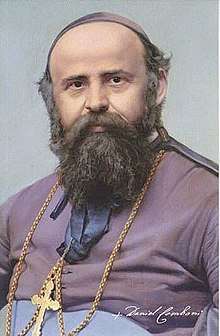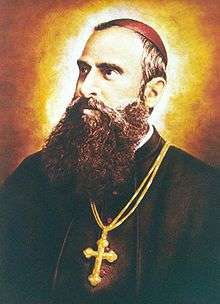Comboni Missionaries of the Heart of Jesus
The Comboni Missionaries of the Heart of Jesus (Latin: Missionarii Comboniani Cordis Iesu), also known as the Comboni Missionaries of the Sacred Heart,[1] the Verona Fathers,[2][3] or the Sons of the Sacred Heart of Jesus,[2][4][3] and originally called the Sacred Heart of Jesus (Congregatio Filiorum S. Cordis Iesu), is a male religious institute of papal law: the members of this congregation, known merely as Comboni, bear the letters MCCI.[5] It was founded on June 1, 1867.[3]
| Abbreviation | MCCI |
|---|---|
| Motto | Serving the world's poorest and most forgotten people. |
| Formation | 8 December 1871 |
| Founder | St. Daniele Comboni |
| Type | Catholic religious order |
| Headquarters | Via Luigi Lilio 80 Rome, Italy |
Superior General | Fr. Tesfaye Tadesse Gebresilasie, M.C.C.J. |
| Website | http://www.comboni.org/ |
History


The congregation was founded by Daniele Comboni (1831-1881), who was born into a humble family of laborers. Comboni entered the institute opened in Verona by Nicola Mazza for the education of the poor. Mazza's institute was also involved in the work of evangelization of the territories of Central Africa.[6]
In 1854, Comboni was ordained a priest, and on 14 February 1858, he settled in the Apostolic Vicarage of Central Africa along with five missionary companions. The mission went poorly; the climate was harsh and the missionaries became ill. Some died within a few months, and in 1859 Comboni himself decided to leave Africa and return home.[7]
In Italy, Comboni devised a plan for the rebirth of Africa: convinced of the need to involve the local people in missionary activity, he thought of creating centers for welcoming, baptizing, and educating the natives so they could act as priests and catechists among their own people. He organized conferences all over Europe to share his idea, as well as speaking with Arnold Janssen and Catholic congregations already engaged in missions in Africa.[7]
On the occasion of Vatican Council I, Comboni prepared a document to be presented to the fathers to try to involve as many ecclesial forces in the work of propagating faith in Africa, but because of the suspension of the Council, the document could not be discussed.[6]
On June 1, 1867, Comboni decided to open a training seminar for clerics in Verona to be used in Africa missions: as a reference model for the organization of the community, the Paris Foreign Missions Society was chosen as a company of priests and lay brothers, without religious vows, but with an oath of loyalty and belonging to the community. The leadership and teaching in the institute were entrusted to the Jesuits.[8]
The missionary society, originally called the children of the Sacred Heart of Jesus, was approved as a congregation of diocesan right on December 8, 1871. On July 31, 1877, Comboni was named apostolic Vicar of Central Africa and moved to Khartoum, where he died in 1881. With the founder's disappearance, his company entered a phase of precariousness: the Mahdist War prevented missionaries from continuing their mission to Sudan. Francesco Sogaro, Comboni's first successor, transformed society into a congregation of simple vows in 1885, but older members did not accept the decision because they believed that religious practices would distract the missionaries from the active apostolate. Only the decision of the Sacred Congregation for the Propagation of the Faith, which approved Sogaro's choice, ended the internal conflicts of the institute.[8]
With the Anglo-Egyptian victory over the Mahdists, the Comboni Missionaries could resume their mission to Sudan. The congregation received the Papal Decree of Praise on June 7, 1895. Since the congregation was now mature and self-sufficient, Antonio Maria Roveggio, successor to Sogaro, in 1899 took on the responsibility of formation of new missionaries from the Jesuits. On February 19, 1910, the Holy See finally approved the institute and its constitutions.[8]
Within the congregation, two groups were soon set up: one formed by Italian religious and the other by the religious of the German-speaking countries. The conflicts between the two factions grew in the years of World War I. On July 27, 1923, the Holy See decided to separate the German branch of the institute from the parent congregation by instituting the Missionaries of the Sons of the Sacred Heart of Jesus, which were approved on 18 March 1924.[9]
Vatican II, which had invited religious institutes to rediscover the charism of their founders, urged the two separate congregational groups to seek the way of unity. As a result, on September 2, 1975, together in the town of Ellwangen, the two groups celebrated the general chapters which decided and ratified the meeting of the two institutes. On June 22, 1979, the Holy See sanctioned the union of the two congregations.[9]
The founder, beatified in 1996, was proclaimed a saint by Pope John Paul II on October 5th, 2003.[10]
Activity and dissemination

The Comboni Missionaries dedicate themselves to the missionary apostolate to the populations that are not yet or not sufficiently evangelized, especially in Africa.[5]
They are present in Europe (Austria, France, Germany, Ireland, Italy, Poland, Portugal, United Kingdom, Spain), Africa (Benin, Central African Republic, Chad, Democratic Republic of Congo, Ghana, Egypt, Eritrea, Ethiopia, Malawi, Mozambique, South Africa, South Sudan,[11] Sudan, Togo, Uganda, Zambia), in the Americas (Brazil, Canada, Chile, Costa Rica, Ecuador, El Salvador, Guatemala, Mexico, Nicaragua, Peru), and Asia (Philippines, Macao, Taiwan).[12] The Mother House is in Via Luigi Lilio in Rome.[5]
At the end of 2008, the congregation had 328 houses with 1,803 religious, 1,296 of whom were priests.[5]
Sexual abuse
Eleven men have alleged that members of the order sexually abused them during the 1960s and 1970s when they were boys at a Comboni Missionaries minor seminary, St Peter Claver College, in Mirfield, England.[13] Four abusers were named in the men’s statements. In 2014, the order paid at total of £120,000 to the men, while saying "All the claims were made on a purely commercial basis and with no admission of liability".[13] A Comboni Missionaries internal inquiry reported that one of the accused, Father Nardo, "had acted inappropriately".[14] In May 2015, the accusers sent a 157-page report including over 1,000 allegations of abuse over several decades to the archbishops of Britain and Ireland, calling on the Comboni Missionaries to acknowledge the alleged abuse and apologise.[15]
See also
- Comboni Missionary Sisters
- Apostles of Jesus
- Caravan of Peace
References
- "Comboni, Daniele, Bl.". New Catholic Encyclopedia: Com-Dyn. New Catholic Encyclopedia. Thomson/Gale. 2003. ISBN 978-0-7876-4008-8. Retrieved 6 July 2017.
- Pace, E.A. (1922). "Sacred Heart, Sons of the (Verona Fathers)". The Catholic Encyclopedia: An International Work of Reference on the Constitution, Doctrine, Discipline, and History of the Catholic Church. Encyclopedia Press. p. 648. Retrieved 11 July 2017.
- Melton, J.G. (2014). Faiths Across Time: 5,000 Years of Religious History. ABC-CLIO. p. 1524. ISBN 978-1-61069-026-3. Retrieved 11 July 2017.
- Durchholz, P. (1999). Defining Mission: Comboni Missionaries in North America. University Press of America. p. 211. ISBN 978-0-7618-1427-6. Retrieved 11 July 2017.
- Ann. Pont. 2010, p. 1451.
- Bertolotti 1997, p. 302-305.
- T. Agostoni, in M. Escobar (Ed.), op. cit., vol. II (1955), pp. 1501-1510.
- Gilli 1976, coll. 1515-1520.
- Rocca 1978, coll. 1445-1446.
- "Tabella riassuntiva delle beatificazioni avvenute nel corso del pontificato di Giovanni Paolo II". Retrieved 13 May 2010.
- "Comboni Missionaries South Sudan". Retrieved 4 August 2017.
- "Missionari Comboniani. Dove siamo: delegazioni e province" (in Italian). Retrieved 13 May 2010.
- Catherine Deveney (19 October 2014). "Catholic missionary compensates 11 former trainee priests". The Guardian. Retrieved 11 July 2017.
- Ansaldo, Marco (13 May 2015). ""Why did you do it?" Former seminarian and priest who abused him come face to face". Repubblica.it. Retrieved 11 July 2017.
- Joanna Moorhead and Liz Dodd (29 May 2015). "Abuse victims at Comboni seminary demand apology". The Tablet. Retrieved 11 July 2017.
Bibliography
- Annuario pontificio per l'anno 2010 [Pontifical directory for the year 2010] (in Italian). Vatican City: Libreria Editrice Vaticana. 2010. ISBN 978-88-209-8355-0.
- Mario Escobar (Ed.), Ordini e congregazioni religiose (2 voll.), Società Editrice Internazionale, Torino 1951-1953.
- Gilli, A., ed. (1976). Dizionario degli Istituti di Perfezione (in Italian). III. Milano, Italy: Edizioni Paoline.CS1 maint: ref=harv (link)
- Rocca, Giancarlo, ed. (1978). Dizionario degli Istituti di Perfezione (in Italian). V. Milano, Italy: Edizioni Paoline.CS1 maint: ref=harv (link)
- Bertolotti, A. (1997). Schwaiger, Georg (ed.). La vita religiosa dalle origini ai nostri giorni [Religious Life from Origins to Today] (in Italian). Milano, Italy: San Paolo. ISBN 978-88-215-3345-7.CS1 maint: ref=harv (link)
External links
| Wikimedia Commons has media related to Comboni Missionaries of the Heart of Jesus. |
